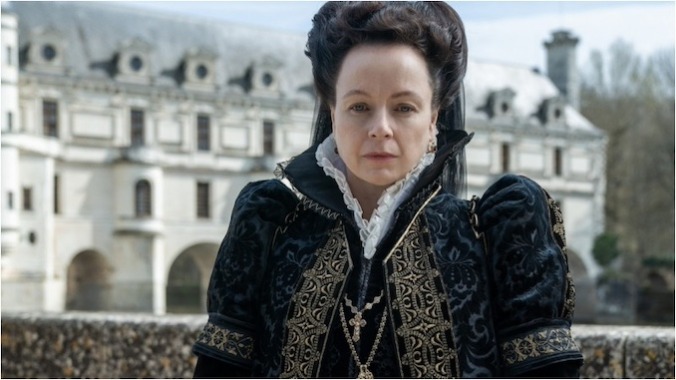Samantha Morton Still Reigns Over The Serpent Queen’s Overcrowded Second Season
Photo Courtesy of Starz
Don’t let the marketing for Starz’s The Serpent Queen fool you. Though the Catherine de Medici series is framed as a dark, edgy historical drama, complete with opening credits that feature star Samantha Morton climbing atop a throne of snakes as a rocking guitar riff wails in the background, the show is much more complicated and interesting than that. An attempt to tell the story of the infamous French queen that history tends to remember as a manipulative bitch at best and a literal witch at worst, The Serpent Queen tries to chart a middle path, granting its central character the agency to shape her own narrative in a way women throughout history have so frequently been denied. The end result wasn’t perfect, by any means, but the series’ first season still managed to say some interesting things about both female ambition and the way history tends to remember powerful women. In its second, The Serpent Queen tries to broaden its narrative focus, with mixed results.
Whereas The Serpent Queen’s first season was about Catherine’s (Morton) rise to power, its second is more focused on her struggle to keep it—by any means necessary. As a result, this is a run of episodes that are somehow both bloodier and more boring than its predecessor, too often sidelining Catherine in the name of focusing on the larger political machinations taking place around her court. The series is ill-suited to tackle the complex issues surrounding the 16th-century French religious wars and the paint-by-numbers approach to the conflict struggles to convey both its scope and the specifics of Catherine’s position at its center. But it is Catherine herself who remains The Serpent Queen’s secret weapon—and the primary reason the show is still worth watching.
Having caught up to the story of her life Catherine was telling at the end of Season 1, The Serpent Queen’s second outing is a more straightforward affair. There are more characters, an increasingly complex political landscape, and fewer questions about whether we can trust the author of the story we’re seeing unfold in front of us. Catherine still regularly breaks the fourth wall, offering sly and frequently biting in-the-moment commentary. But she is no longer the unreliable narrator offering a questionable framework for what we see.
Instead, Season 2 offers us greater insight into the complicated and ever-shifting image Catherine must craft for the benefit of those around her, and the show is surprisingly honest about both how much work this requires and the emotional toll it takes on her. There are moments across this season’s eight episodes (all of which were available to screen for critics) where Catherine is genuinely sympathetic and compelling, even as she makes selfish, manipulative, and often downright horrifying decisions. While she is a woman who can also be a monster, The Serpent Queen isn’t interested in judging her choices, merely contextualizing the reasons she might have made them.
Morton remains this series’ greatest strength and most compelling performer. Her Catherine effortlessly adopts a variety of personas depending on who she’s talking to and what she’s trying to accomplish, switching between the roles of a reluctant leader, concerned parent, unrepentant schemer, and lonely queen with an agility that leaves us wondering how much of the real woman anyone is ever truly allowed to see. Morton seems to revel in complicating her portrayal of the Medici queen whenever possible, embracing Catherine’s sharp mind and impressive political self-awareness even as she leans into her desperate desire for family and genuine connection. Her performance is fearsome and fearless, and the show finds itself dragging whenever its eponymous main character isn’t onscreen.
Unfortunately, that happens more than many of us might like in Season 2. The story jumps forward about a decade from the events of the first season finale, skipping over the bulk of Catherine’s Regency when she would have been at the height of her power and dropping us smack into the reign of her now adult second son, King Charles IX (Bill Millner). As a result, the scope and scale of The Serpent Queen rapidly expand, incorporating nearly a half-dozen of Catherine’s adult children, various new members of prominent court families, servants, and more. But while there are certainly more characters to keep track of this season, the problems France is facing are largely the same.
Tensions remain high between French Catholic and Huguenot (a.k.a. Protestant) factions, represented at court by the squabbling Guise and Bourbon families who are constantly jockeying for power. But the sudden appearance of a gifted Protestant preacher named Edith (Isobel Jesper Jones) throws the country further into turmoil and closer to all-out civil war. The Serpent Queen has never been particularly skilled at explaining the complex nature of the religious conflicts during this period, a fact which becomes glaringly apparent here, when so much of Charles’ reign was defined by this particular flavor of unrest. Despite its increasing focus on religious differences, the show provides precious little context for viewers unfamiliar with the major disputes between Protestants and Catholics, or why it mattered which religious group held power in which particular country. The largely interchangeable feel of many of the various Guises and Bourbons doesn’t help matters, and the size of the series’ sprawling cast means that most supporting characters remain woefully underdeveloped.
-

-

-

-

- Curated Home Page Articles By Test Admin October 21, 2025 | 3:10pm
-

- Curated Home Page Articles By Test Admin October 21, 2025 | 2:57pm
- Urls By Test Admin October 21, 2025 | 2:57pm
- Curated Home Page Articles By Test Admin October 21, 2025 | 2:55pm
-

-

-

-

-

-

-

-

-

-

-

-

-

-

-

-

-

-

-

-

-

-

-

-

-

-

-

-

-

-

-




































